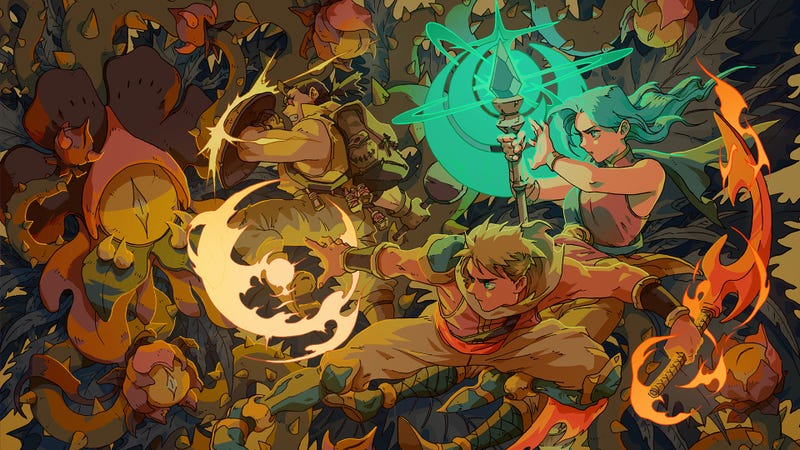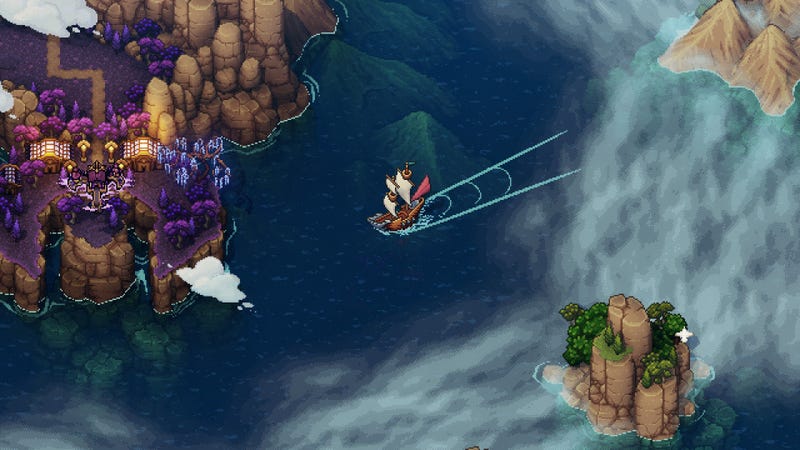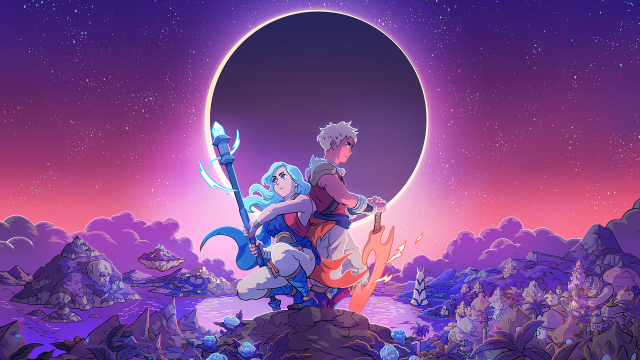There are a lot of games to play in 2023, so many that right after I beat Sea of Stars, the new indie RPG inspired by genre classics like Chrono Trigger, I immediately turn my attention to Baldur’s Gate 3. The switch reflects a jarring sea change in the design of role-playing games: after downloading the 109 GB file to my PS5, I am besieged by an array of menus asking me to pick a bunch of specifications for my character. That I am temporarily overwhelmed with the number of options has less to do with Baldur’s Gate 3, an enthralling game that has quickly become my new obsession, and everything to do with the starkly different approaches to game design and mechanics that are felt when switching from a retro-inspired JRPG to a massive, open-world Dungeons & Dragons adventure.
If you’re not familiar with Sea of Stars, the game centers on Valere and Zale, two Solstice Warriors who use the power of the moon and sun to defend their world from an all-consuming threat. As with many RPGs, it features a main quest that brings you from hamlet to hamlet and through memorable dungeons, collecting weapons and helping out the local townspeople along the way. It sports a cartoony aesthetic that pairs well with its decidedly optimistic and quirky tone–like its haunted swamp dungeon, which is more “Spooky Scary Skeletons” than actually fright-inducing.
But Sea of Stars’ magic lies in its simplicity, in its consistent linear movement forward and its succinct combat. In a year when AAA games like Baldur’s Gate 3, Diablo 4, and Starfield often take more than 100 hours to finish and feature countless menus that offer endless customization, Sea of Stars revels in its clarity, telling its main story in a tight 20-ish hours. The juxtaposition makes me appreciate Sea of Stars even more, and I’m not alone, as it’s managed to become a hit for developer Sabotage Studio, even among the year’s blockbuster-heavy field.. Clearly, its straightforward gameplay, limited movesets, and small world map offer something special in a sea of games that ask you to spend time tweaking their experience to suit your individual preferences.

The simplicity of Sea of Stars
As its designers have pointed out, Sea of Stars wears its influences (like Chrono Trigger and the Super Mario RPG) on its sleeve, and especially in its combat, which emphasizes dual combos and timed attacks. “Playing Sea of Stars immediately pulled me back to my adolescent years glued to my Super NES,” games writer Aidan Moher said in his book Fight Magic Items: The History of Final Fantasy, Dragon Quest, and the Rise of Japanese RPGs in the West. “But it also felt like a maturation of the genre, something shaped by twenty-first-century game design.” In Moher’s view, games like Sea of Stars are in-line with the larger cultural nostalgia occurring in almost every medium. But rather than the boring retread of another updated reboot or remake, Sea of Stars revels in the simple. It isn’t interested in changing what was great about old games, just in polishing those edges for a 21st-century player.
All the hallmarks of classic JRPGs are present in Sea of Stars, but reflecting the game’s focus, they’re on the more restricted end of the genre’s possible gamut. For instance, in most JRPGs, you learn a set of moves that gradually increase in strength over time, like Cloud or Tidus learning new abilities as their respective Final Fantasy entries progress. Sea of Stars does offer new moves, but to an extremely limited degree. Whereas in other games, you can update spells and moves over time, Sea of Stars gives each character a limited moveset of about three or four normal moves, as well as a couple of combo attacks and one ultimate attack, and that’s all you get for the entire game.
Rather than allowing players to edit or change their moves, some of the first attacks you learn (such as Zale’s fiery Sunball or Valere’s projectile Moonerang) stick with you until the game’s end credits roll, forcing you to master them over time rather than abandon them for something more powerful. And the requirement to press a button at just the right time in order to power up these attacks, or to deflect incoming damage, keeps the combat involving. Mashing a button in pursuit of a particular outcome feels classic, akin to making sure Mario times his jump over a swirling fiery ring to evade death.
Sea of Stars’ use of pixelated sprites stands in stark contrast to some of the more high-profile RPGs released in the last year, including Baldur’s Gate 3 and Diablo 4, as well as games like Midnight Suns. The character designs use simple but striking color associations to reflect and underscore each persona’s affinity: Valere’s orange-tinted tips reflect his fiery moveset, while Valere’s blue hair aligns with her lunar powers, and Seraï’s green aura embodies her venom-based skills. As with many classic RPGs, you can update their swords and armor, but the design doesn’t really change as the story progresses along its linear plotline.

And just as the characters are not endlessly customizable, the world is not one in which you are allowed to roam freely. When you move between locales in Sea of Stars, the map resembles the one in Super Mario World, where characters march in a straight line from one location to the next. It feels even more closed off than the old NES Final Fantasy games, which I played via the recent Pixel Remaster releases. It was jarring, at first, to realize I couldn’t move in whatever direction I wanted, but after a while I came to respect the game’s guiding hand, pushing me along its timeline and its story in a straightforward direction.
I’m not pitting simple video games against complex ones here—there is room for both massive MMORPGs and small-scale indies on your hard drive. But Sea of Stars shows off a deep appreciation of core gameplay aspects that sometimes don’t get to shine in the modern world of endless bells and whistles. As a lifelong fan of turn-based RPGs, it can feel like some of the hallmarks of the genre, including turn-based combat, have fallen out of favor, and Stars is a reminder that we shouldn’t throw the baby out with the 32-bit bathwater. It asks you to solve simple puzzles, master a limited number of moves, and walk in straight lines on its world map; each of these tasks is a fierce argument for how special simple games can be.
I have spent hours in customization menus for many games, but there is something equally thrilling about being tossed into a world that asks you to think very little and to let a gorgeous story wash over you. Sea of Stars is already a hit and, according to a recent post on its social media account, has already sold over 250,000 copies since it launched in late August, despite also being available for “free” on subscription services like PS Plus and Game Pass. Seeing its success, alongside the recent release of the under-heralded Chained Echoes, gives me hope that a new crop of games will continue to embrace the simplicity that made us fall in love with video games in the first place. As video games get bigger and bigger in scope, it’s worth taking a trip back to their fundamentals to remember why we were first glued in front of our screens.

Leave a Reply